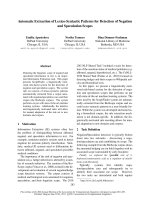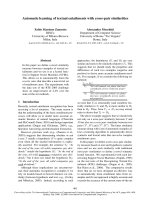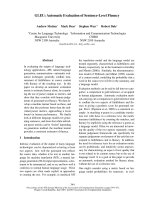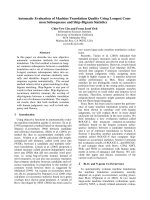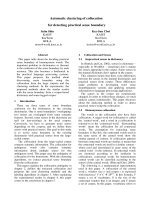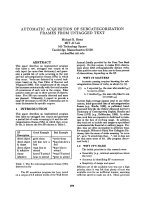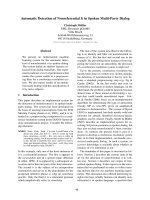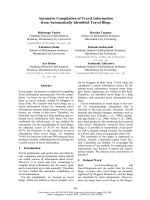Báo cáo khoa học: "Automatic Acquisition of Script Knowledge from a Text Collection" docx
Bạn đang xem bản rút gọn của tài liệu. Xem và tải ngay bản đầy đủ của tài liệu tại đây (435.4 KB, 4 trang )
Automatic Acquisition of Script Knowledge from a Text Collection
Toshiaki Fujiki
Hidetsugu Nanba
Interdisciplinary Graduate School of Graduate School of
Science and Engineering
Information Sciences
Tokyo Institute of Technology
4259 Nagatsuta-cho, Midori-ku,
Yokohama, JAPAN
Hiroshima City University
3-4-1 Otsukahigashi,
Asaminami-ku, Hiroshima,
Manabu Okumura
Precision and Intelligence
Laboratory
Tokyo Institute of Technology
4259 Nagatsuta-cho, Midori-ku,
Yokohama, JAPAN
JAPAN
Abstract
In this paper, we describe a method for
automatic acquisition of script knowl-
edge from a Japanese text collection.
Script knowledge represents a typical
sequence of actions that occur in a
particular situation. We extracted se-
quences (pairs) of actions occurring in
time order from a Japanese text collec-
tion and then chose those that were typi-
cal of certain situations by ranking these
sequences (pairs) in terms of the fre-
quency of their occurrence. To extract
sequences of actions occurring in time
order, we constructed a text collection in
which texts describing facts relating to a
similar situation were clustered together
and arranged in time order.
We also describe a preliminary exper-
iment with our acquisition system and
discuss the results.
1 Introduction
Script is a term proposed by Schank, and it refers
to a form of knowledge representation. Script
knowledge is a body of knowledge that describes
a typical sequence of actions people do in a par-
ticular situation(Schank and Abelson, 1977). For
example, when we go to a restaurant, we usually
'enter the restaurant', 'wait', 'sit down', 'get the
menu and decide what to eat', 'order the dish',
'wait until the dish has come', and so on. This
sequence can be said to be script knowledge in the
situation of 'eating at a restaurant'.
Script knowledge has been used in natural lan-
guage processing, especially for word sense dis-
ambiguation, text generation, and automatic text
summarization(Dejong, 1982). However, most
studies have used only small portions of script
knowledge manually generated by the authors. We
need a large-scale knowledge database; however,
manually producing such a database would cost
too much.
In this paper, we propose a method for au-
tomatic acquisition of script knowledge from a
Japanese text collection. Because script knowl-
edge represents a typical sequence of actions
formed in a particular situation, we extracted se-
quences (pairs) of actions that occur in time order.
We then chose among these actions the ones that
are typical by ranking them in terms of the fre-
quency of their occurrence. To extract sequences
of actions that occur in time order, we constructed
a text collection in which texts describing facts re-
lating to a similar situation were clustered together
and arranged in time order.
In Section 2, we describe our proposed method
and show how we constructed the text collection.
In Section 3, we describe a preliminary experi-
ment with our acquisition system and discuss the
results.
2 Proposed Method
Our method consists of the following three steps:
1. Constructing a text collection.
91
2.
Extracting sequences (pairs) of actions from
the text collection.
3.
Selecting typical sequences.
We show the outline of our method in Figure
1, where the process of automatic acquisition of
script knowledge related to 'murder case' is de-
scribed. In the following subsections we explain
these steps in greater detail.
2.1 Constructing a Text Collection
To use our method, we need to construct a text col-
lection that has the following three features: The
texts in the collection describe only facts. The
texts are arranged in time order. The texts are on a
similar topic.
To construct a text collection that satisfies the
above conditions, we used a corpus of newspaper
articles and performed the following steps: First,
we retrieved news reports on a topic, and clustered
them into subtopics. In this step, we used an auto-
matic text clustering system(IPA, 2002). Next, we
extracted only the first paragraph from each report,
and arranged the paragraphs in clusters based on
the date of issue of the report. We used only the
first paragraphs of the news reports because they
tend to describe facts in time order.
After that, the sentences in the text collection
were syntactically analyzed by using a Japanese
syntactic analyzer, KNP(Kurohashi and Nagao,
1994).
2.2 Extracting Pairs of Actions
In this section, we describe three cases where two
actions occur one after the other and can be ex-
tracted as a pair of actions. Let us first explain
what we mean by 'action', 'pair of actions', and
'sequence of actions' in this paper. In this work,
an action is defined as a tuple of a transitive verb,
its subject, and its object. We use the Japanese
postpositional particles
/P
and to detect sub-
jects, and ' to detect objects. A 'pair of actions'
consists of two actions that occur in time order. A
'sequence of actions' can be defined as a transitive
closure of all the pairs of actions.
1. Cases where verbs in different sentences have
the same subject and object
When two verbs in different sentences in a
cluster have the same subject and object, a
pair of actions can be extracted. For example,
consider the following two sentences.
(The police
police found the suspect.)
-1k
tffi
1-, k
o
(The police arrested the suspect.)
Two verbs('
I't
A
(find)' and 'IN (arrest)')
have the same subject ("R.
., (police)') and
object ("-74M
-
(suspect)'). In this case, the
latter action (sentence) occurs after the for-
mer. Therefore, a pair of actions (C%-l-qh%4
Vklz6A
4
-
6
(police finds suspect)'), (`Sc
Vtti
(police arrests sus-
pect)')) can be extracted.
Note that in this case we take advantage of
the fact that the sentences in the cluster are
arranged in time order.
2.
Cases where two verbs describe a continuous
modification of the object in a sentence
W-MV4kk4z6A Us 5.t1f4L
ko
(The police found the suspect, and
arrested him )
In the above example, the verb
`1=6A
6
(find)' and the verb
`MIffil
—
6
(arrest)'
describe a continuous modification relation.
When two verbs have this relationship, they
tend to be in time order. Therefore, in this
case a pair of actions can be extracted.
3.
Cases where the main verb and the verb of
the relative clause have the same noun as the
object
In these cases, the verb in the relative clause
should be in the past tense (auxiliary verb
'
should be attached to the verb).
it4YR
(The police arrested the suspect
whom they had found.)
In the above example, the verb
16R1
-
L
(find)' modifies the noun
V-MAs
(suspect)',
and
V.RA
-
(suspect)' is the object of Altt
92
Find
Arrest
Rrid
Arrest
Arrest
—0
Procesute
Surrender — Arrest
Arrest —• Prosecute
Extract palm of actions
Use only first paragraph
Murder
Casel
Murder
Case3
Extract
-
typical pairs of actions
as script knowledge
( Arrest
Procenute
Find
Arrest
Arrest
Escape
Nl
ewspaper
Corpus
Cluster news reports
into subtopics
Figure 1: Outline of Our Method
1
-
6
(arrest)'.
In such a
case, two
actions can
be
thought to occur in time order. Therefore,
a pair of actions can be extracted.
The verb in the relative clause must be in the
past tense, because the action in the relative
clause does not necessarily occur before the
action in the main clause when the verb in the
relative clause is in the present tense. Con-
sider, for example, the following two sen-
tences:
ttliq
(He visited the doctor whom he
trusted.)
ttAta
Ad)
(He decided on the doctor to visit.)
The verbs(`C
VI
-
(trust)' and
ta
(visit)') in the relative clauses of both the sen-
tences are in the present tense, and the actions
in the relative clauses do not occur before the
actions in the main clauses. Therefore, we
extract a pair of actions only when the verb
in the relative clause is in the past tense.
In Japanese, the subject and object of a verb in a
sentence may be omitted. In such cases, to extract
a pair of actions, we naively supplemented them
by using the noun phrase that appeared before the
verb and satisfied the selectional restriction of the
verb.
Passive sentences also cause a problem, since
passivization often changes the case of the verb.
Therefore, we generated patterns where the case
of the verb changes to obtain passive cases from
the active ones.
2.3 Selecting Typical Pairs
At this step, we selected typical pairs of actions
from the extracted pairs. First, we generalized the
extracted pairs by changing subjects and objects
into semantic features and merging similar verbs
into one by using Japanese thesaurus `Bunrui Goi
Hyo' (NLRI, 1964). As a result of this generaliza-
tion, we could easily determine whether two pairs
are same and count the frequency of occurrence.
Next, pairs of actions were assigned a score
based on the frequency of occurrence. Pairs with
a score exceeding predetermined threshold value
were considered typical. Typical sequences of ac-
tions were then constructed as a transitive closure
of all the selected typical pairs and, acquired as
script knowledge.
3 Preliminary
Experiment
We conducted a preliminary experiment with our
system for automatic acquisition of script knowl-
edge and investigated the effectiveness of our
method. We used issues of Nihon Keizai Shim-
bun for the past 11 years (1990-2000) as a news-
paper corpus and GETA(IPA, 2002) for automatic
text clustering. In the case of script knowledge re-
lated to 'murder case', using the keyword 'murder
case', we collected 4489 news reports, and these
were clustered into 617 clusters.
As a result, 41 pairs of actions were extracted
(the threshold was set to 2). Figure 2 shows part
of the acquired script knowledge. In the figure,
the time order between the actions is indicated by
the arrows. For example, lorganization] arrests
[human]' follows `[organization] finds [human]'
93
[organization] arrest [human]
[human] surrender [act]
[organization] search [home]
[organization]
re-arrest [human]
><
Unfortunately, the acquired script knowledge
does contain some errors. For example, the pair
of actions lorganization] arrests [humanY follows
`[organization] re-arrests [human]' in Figure 2 (the
arrow is marked with a cross) is not in the right
time order. This error is considered to be caused
by generalizing different suspects to the same se-
mantic feature [human].
Some other errors included those made in the
syntactic analysis, wrong results of text cluster-
ing(these are the errors of the tools used), errors in
supplementing omitted subjects and objects, and
errors resulting from incorrect interpretation of
passive sentences (these are the errors originating
in our naive methods of analyzing Japanese sen-
tences).
4 Conclusion
In this paper, we proposed a method for automatic
acquisition of script knowledge from a Japanese
text collection. We described a preliminary exper-
iment with our acquisition system and discussed
the results.
In the future, we want to devise a better method
for dealing with passive sentences and supple-
menting omitted subjects and objects. We also
plan to objectively (extrinsically) evaluate our sys-
tem for other tasks such as automatic text summa-
rization.
We think our method can work with other lan-
guages, though there must be some modification
on syntactic analysis and definition of 'action'. We
think script knowledge and structure of newspaper
articles are language independent.
Our method of script knowledge acquisition has
a few limitations. First, the method can acquire
only the script knowledge with common subjects
and/or objects. This limitation comes from our
[organization] find [human]
•
•
[organization] prosecute [human] ([J indicates semantic features)
Figure 2: Result of the Experiment
restrictions in extracting pairs of actions. If we
don't impose these restrictions, however, much er-
roneous script knowledge might be obtained.
Second, since our method is based on the
characteristics of the text collection we construct
(news reports in time order clustered into simi-
lar subtopics), it cannot correctly acquire script
knowledge when the time order of the reports is
not the same as the time order of the actions, as
is the case, for example, with reports about kid-
nappings (news reports about kidnappings natu-
rally come after the event). Third, because we
used only the first paragraphs of the news reports,
script knowledge could not be obtained from the
background information in later paragraphs.
To cope with the third problem, we need to use
whole news reports and analyze their rhetorical
structure(Marcu, 2000) to clarify the time order
among the sentences. We are now building such
a rhetorical structure analyzer for Japanese news
articles, and will report the results of our work in
the future.
References
Gerald F. DeJong. 1982.
An overview of the FRUMP
system.
Wendy G. Lehnert and Martin H. Ringle,
editors, Strategies for Natural Language Processing,
pages 149-176. Lawrence Erlbaum Associates.
Koichi Hori, Tadao Saito, and Hiroshi Inose. 1983.
Inductive Learning of a Script From the Text(in
Japanese).
Information Processing Society of
Japan, Special Interest Group on Natural Language
Processing Research Report 37-5
IPA(Information-technology Promotion Agency,
Japan). 2002.
Generic Engine for Transposable
Association: GETA.
/>Sadao Kurohashi and Makoto Nagao. 1994.
KN
Parser: Japanese Dependency/Case Structure An-
alyzer.
In Proceedings of The International Work-
shop on Sharable Natural Language Resources,
Nara, Japan, pages 48-55.
Daniel Marcu. 2000.
The Theory and Practice of Dis-
cource Parsing and Summarization.
The MIT Press.
National Language Research Institute, editor. 1964.
Bunrui Goi Hyo(in Japanese).
Shuei Shuppan.
Roger C. Schank and Robert P. Abelson. 1977.
Scripts,
Plans, Goals, and Understanding: an Inquiry into
Human Knowledge Structures.
Lawrence Erlbaum
Associates.
94
